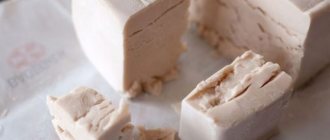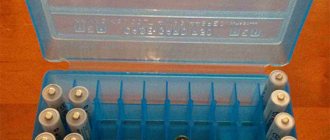Can it be frozen?
GOST establishes the possibility of storing cottage cheese in the freezer.
Such cottage cheese retains its nutritional and consumer qualities, but the product must be thawed before use. The shelf life of frozen cottage cheese varies depending on the temperature of the freezer, the type of product and the type of packaging:
- in industrial freezers at a temperature of -35 °C, cottage cheese and products made from it are stored for a period of six months to a year;
- cottage cheese can be stored in home freezers at a temperature of -18 °C for one to two months;
- in weak freezers of old or low-quality refrigerators at temperatures from 0 to -15 °C, the shelf life of frozen curd products ranges from 6 to 14 days.
If heat treatment of the curd product is intended, then it can be defrosted at room temperature, however, the nutritional quality of such cottage cheese is sharply reduced.
Cottage cheese perfectly retains its nutritional value when frozen. Depending on its fat content, when defrosted, the product releases a certain amount of whey.
The package with the product is placed in the freezer, setting the temperature to no higher than minus 18 degrees.
The curd can remain in the chamber for up to 2 months.
You cannot defrost or freeze it again: from such manipulations, the milk protein contained in it loses its beneficial properties.
Using a freezer, you can not only extend the shelf life of store-bought cottage cheese, but also prepare a healthy treat yourself with minimal time and effort. We share with you a recipe for a delicious curd mass made from kefir:
- Kefir with a fat content of 3.2% is placed in the freezer until completely hardened. To freeze, the liquid can be poured into a suitable container or left in the package.
- The frozen fermented milk product is removed from the packaging and placed on a sieve covered with gauze, under which there is a saucepan. It will look like the following photo.
- The structure is stored in the refrigerator or a dark, cool place for thawing. It is not recommended to use a microwave or stove to speed up the process.
It is advisable to consume the paste within 24 hours after preparation.
Cottage cheese perfectly retains its nutritional value when frozen. Depending on its fat content, when defrosted, the product releases a certain amount of whey. Therefore, the easiest way is to store the product not in its pure form, but in frozen semi-finished products, for example, dumplings, cheesecakes, stuffed pancakes, etc.
Differences by product type
Depending on the conditions under which the curd product is stored and the type of product, different storage periods are established:
- Cottage cheese in vacuum packaging , which excludes contact of the product with air, can be stored in the refrigerator for up to 1 month.
- Loose cottage cheese sold on the market is best consumed within 24 hours, since the exact timing of its production is not guaranteed.
- Homemade cottage cheese made using heating should preferably be consumed within 48 hours. To store such cottage cheese, it is better to use a tightly closed container.
- Ready-made dishes made with cottage cheese (cheesecakes, dumplings, pies, cheesecakes, pancakes) are stored in the refrigerator for no more than 24 hours.
- Children's cottage cheese , produced using more advanced heat treatment and packaging technologies (Frutonyanya, Agusha), can retain consumer qualities for up to 14 days.
To achieve such deadlines, the manufacturer receives special permission from the SES.
Legislation
- GOST R 52054-2003 “Raw cow's milk. Technical Specifications" applies to raw materials produced within the country, as well as imported into the territory of Russia, intended for further processing.
- GOST R 54340-2011 “Fermented milk and dairy products. General Technical Conditions" applies to heat treatment for direct consumption.
- GOST 31450-2013 “Drinking milk. Technical Specifications” lists the requirements for the product packaged in consumer packaging after heat treatment or unprocessed.
- SanPiN 2.3.2.1324-03 “Hygienic requirements for shelf life and storage conditions of food products” establishes hygienic requirements to ensure safety and nutritional value during production, transportation, circulation, as well as during their development and putting on the conveyor.
- GOST 31449-2013 “Raw cow's milk. Technical Specifications" applies to raw materials subjected to primary processing after milking and intended for industrial processing.
- GOST 31453-2013 “Cottage cheese. Technical Specifications" covers a product packaged in consumer packaging made from cow's milk and/or dairy products intended for direct consumption.
- GOST 32261-2013 “Butter. Technical Specifications" applies to goods made from cow's milk and/or dairy products, by-products of milk processing, intended for direct consumption, culinary purposes.
- SanPiN 2.4.1.3049-13 “Sanitary and epidemiological requirements for the structure, maintenance, provision of operating hours of preschool educational organizations”
Suitability according to GOST
On July 1, 2014, GOST 31453-2013 “Cottage cheese. Technical conditions". The document regulates the rules for the production, storage and transportation of cottage cheese.
You can learn a lot of interesting things from it, incl. and about chemistry , which, although in minimal quantities, is still present in the product. We are talking about E-509.
Calcium chloride dihydrate is used to reduce the cost of dairy products and as an effective emulsifier (approved by TU 6-09-5077-83 and TU 6-09-4711-81).
GOST requires manufacturers to independently set product expiration dates, which depend on the characteristics of the technological process and packaging.
, the fat content of the product must be taken into account - the higher the percentage of its content, the shorter the period when you need to eat it.
In this article you will learn what the shelf life of kefir is, and what to do with it if it goes missing.
Is it possible to freeze cottage cheese?
You can and should freeze cottage cheese if you do not plan to use it in the near future, but this process must be carried out in compliance with all the rules. In this case, its shelf life will reach several months. When defrosted, the taste will remain the same, but there is a high probability of a change in consistency. Frozen grained cottage cheese will turn into a curd mass. It is still not advisable to store it all winter.
When making cottage cheese with your own hands, it is not recommended to store it for a long time. The whey should be drained immediately. It is advisable to consume the cottage cheese itself as soon as possible.
How to keep outside the refrigerator?
Strict deadlines and restrictions are established for storing cottage cheese outside of refrigeration devices.
At a temperature not exceeding +15 ° C , the cottage cheese should be covered with a cloth soaked in water and stored in a dry place without exposure to sunlight for no more than one day.
Only under such conditions can cottage cheese retain its consumer qualities. In opposite cases, especially if the storage temperature is more than +15 ° C, the curd product is suitable for consumption within a period not exceeding several hours .
How to pack correctly
Correctly selected packaging will ensure good preservation of the cottage cheese. When left open for a long time, it dries quickly and absorbs aromas. Different packaging is used to store this fermented milk product.
Vacuum
Vacuum packaging will allow you to extend the freshness of cottage cheese for up to 4 weeks. In sealed conditions in the absence of oxygen, the vital processes of lactic acid bacteria slow down.
Foil and parchment paper
This packaging is suitable for storing low-fat cottage cheese, which does not contain excess moisture. Small portions are wrapped in parchment or foil and can be kept in the refrigerator for no longer than 36 hours.
Cotton fabric
Very often, a clean piece of cotton fabric is used to store cottage cheese. Condensation does not form on it, the product does not dry out. But due to the breathability of this material, the packaging should be kept away from food with a strong odor.
Enamel and glassware
This product can be kept in glass bowls or enamel pans. But the dishes must be tightly closed with lids.
Clay containers
In the old days there were no refrigerators, and perishable foods were stored in deep cellars, where it was cool all year round, using earthenware. But this method can also be used now, when it is not possible to use the refrigerator.
A thick layer of salt is poured into a deep clay bowl. Cottage cheese is placed on top and compacted well. Everything is covered with a piece of cotton cloth soaked in a concentrated salt solution. The edges of the bowl are tied and stored.
Benefits of cottage cheese
Cottage cheese is easily absorbed by the body and contains from 13 to 19% balanced proteins. It is also rich in various vitamins and amino acids, fluorine, copper, sodium, phosphorus, zinc, iron and folic acid, which is necessary for pregnant women and girls planning pregnancy.
Cottage cheese reduces cholesterol and fat deposits in the body. It is necessary to consume cottage cheese for people suffering from diseases of the cardiovascular and nervous systems, diseases of the musculoskeletal system, and gastrointestinal tract.
How long can you eat an expired product and is it dangerous?
Eating cottage cheese after its expiration date is highly discouraged, since this fermented milk product contains live lactic acid microorganisms. And they, if the storage conditions and periods are violated, can turn from a normal state into a conditionally pathogenic one, which can lead to poisoning.
Also, during the storage of fermented milk products, they form:
- coli bacteria;
- yeast;
- mold;
- staphylococci;
- salmonella.
You can read about the shelf life and storage rules for fermented milk products such as kefir in another article.
This group of bacteria, by default, is already opportunistic and under certain conditions (high humidity, favorable temperature, weakened human immunity), it can acquire pathogenic properties that can lead to severe forms of poisoning and even death.
But cottage cheese with an expiration date or a specimen that has not changed its organoleptic properties several days before the expiration date can be eaten. To do this, it must be subjected to heat treatment. For example, prepare cheesecakes, dumplings, casseroles, etc.
Important! The product subject to heat treatment should not be stored for a long time, but it is better to eat it immediately.
In order to make sure whether the cottage cheese has spoiled or not, you should pay attention to the following signs that indicate its spoilage:
- rich yellow color of the mass;
- heterogeneous mass, with lumps that vary greatly in size;
- pronounced sour odor;
- unpleasant moldy taste.
Shelf life and storage of food products are important, because the consumer hopes that only high-quality goods will end up in his basket. You can find out about the periods and conditions of preservation and shelf life of sweets, honey, bread, flour, coffee, tea, wine, beer and mushrooms in separate publications on our Internet portal.
Summarizing the above material, it should be emphasized that both the manufacturer and the buyer must comply with the standards and rules for storing finished cottage cheese and products based on it. Since this product tends to quickly deteriorate and lose useful substances necessary for the human body.
Curd
Curd mass is a dairy composite product and is not essentially pure cottage cheese. In addition to cottage cheese, the mass includes vegetable and milk fats, sugar or condensed milk, as well as substances with an antiseptic effect.
If you decide to purchase curd mass, pay attention to the consistency - it should be homogeneous, without grains. If particles are clearly visible in the mass, it means that artificial thickeners were used in production. Also carefully study the packaging, which should indicate vegetable fat if it was used as a milk substitute.
Curd mass without additives that increase preservation remains of high quality for 3 days. If the product is packaged in cups and hermetically sealed, the shelf life will increase to 1 week.
Choosing containers for storing fermented milk products: 5 options
| Option 1: airtight container An airtight container is suitable for storing freshly prepared homemade cottage cheese. Shelf life: 3 days | |
| Option 2: plastic bag Due to the complete absence of air and moisture circulation inside the bag, the shelf life of cottage cheese in such containers is much shorter. Shelf life: 36 hours | |
| Option 3: enamel cookware The enamel surface cools quickly, providing the product with stable cold:
Shelf life: 5 days | |
| Option 4: clay container Any clay container with a lid will do:
Shelf life: 3 days | |
| Option 5: salad bowl If you are going to consume the fermented milk treat during the day, you can also store it in a regular salad bowl, covered with a damp cloth. Shelf life: 24 hours |
Storage without a refrigerator - is it possible?
It is known that pure milk can be boiled and the butter wrapped in paper moistened with salt water. Whereas long-term storage of any fermented milk products in the refrigerator is extremely difficult. There are two storage methods inherited from our grandmothers.
- The walls of an enamel dish or barrel are treated with hot steam, and the bottom is filled with salt. The cottage cheese is placed tightly into the container prepared in this way, and covered on top with a piece of cloth soaked in saline solution. A pressure is placed on the top of the lid.
- The cottage cheese is compacted into a dry, clean jar so that air does not penetrate inside. Cotton fabric soaked in saline solution is placed on top. The jar is placed in a cool, dark place.
It should be remembered that not only in room conditions, but even at temperatures inside the refrigerator, pathogenic microflora begins to grow over time and the fermented milk product deteriorates.
Storing rustic and homemade cottage cheese
Cottage cheese made independently by heating sour milk has a short shelf life. It is recommended to keep it in the refrigerator for no more than 48 hours on a shelf located near the freezer. To store the product, you can use foil or a slightly moistened natural cloth, wrap the fermented milk product in it, and then put it in a tightly closed container.
Another good way to store a homemade product is as follows:
- Add some salt to a glazed clay bowl.
- Place the cottage cheese and compact thoroughly.
- Cover the container with a cloth soaked in salt water and press it down with a plate on which to place a weight.
- Put the dishes in the refrigerator.
Is it possible to freeze cottage cheese in the freezer?
How to properly store buckwheat in the form of porridge and cereals
Proper storage of chicken breast, raw and cooked
An important question is how to store country cottage cheese, which is sold in a plastic bag. The product often has a high fat content, so it is advisable to eat it on the day of purchase or the next day
When placing the fermented milk mass in the refrigerator, it is important to transfer it to any tightly closed container, since in the bag it will quickly acquire a musty smell and sour taste
We put it in the freezer and take it back.
To get a high-quality prepared product, first of all you need to use fresh cottage cheese, just purchased from a trusted seller. The temperature in the freezer should be no warmer than -18°C, and the product itself should be carefully packed in a container or plastic bag. To avoid having to defrost a large volume of product at once, package the curd into single serving portions and mark the freezing date. Thanks to these simple rules, using a frozen product will be as effective and useful as possible.
To defrost, just place a portion of the curd on the middle shelf of the refrigerator. Since such defrosting takes several hours, to speed up the process, you can immediately place the workpiece at room temperature or, if necessary, use a microwave oven.
Proper freezing
It is not difficult to properly freeze such a product in the freezer. It is permissible to freeze at a temperature of two degrees below zero. By lowering the temperature to minus 12 degrees, you can increase the shelf life to two weeks. Before eating, you need to take out the portion that will be used and place it on the bottom shelf of the refrigerator. There is a minimum temperature in the entire refrigeration system. This is necessary in order not to expose the protein to sudden changes in temperature, because in this case its original properties are lost.
Rice. 4 – Frozen cottage cheese
The remainder of the product should be placed back in the freezer. Only with this use will it retain its taste and texture. If you plan to fry cheesecakes from this product (or prepare it in another way that involves heat treatment), then you can defrost it immediately at room temperature or in the appropriate microwave mode. Thawed food is best used immediately. The maximum shelf life after defrosting is one day. It is strictly forbidden to freeze cottage cheese again.
It is worth understanding that the longer a product is stored in the freezer, the worse its taste and texture will be when defrosted. At freezing temperatures below -24 degrees, it can last about a month. But as said earlier, it loses its texture and crumbles when defrosted.
If you follow the above rules, the cottage cheese will remain fresh for a long time.
Why can cottage cheese go bad?
We suggest finding out why food spoils. The main cause is oxidation and microorganisms. There are various bacteria in food that begin to actively multiply. They cause decomposition and fermentation of food. Microorganisms secrete substances that impair the taste of dishes. Oxidation also occurs due to exposure to oxygen. Vitamins gradually begin to break down. Almost everyone has experienced food chapping. This situation occurs when there is high air humidity, close to 100 percent.
Conditions and periods of storage of dairy products
| Product name | Product storage conditions | ||
| Storage temperature, °C | Relative humidity, % | Acceptable storage period | |
| Mayonnaise | 0…+18 | no more than 75% | |
| Margarine | -20…-10 | — | 60-90 days |
| -9…0 | 75-45 days | ||
| 0…+4 | 60-35 days | ||
| +5…+10 | 45-20 days | ||
| +11…+15 | 30-15 days | ||
| Cow butter, butter | -10…-12 | 5-10 months | |
| no higher than 6°C | no more than 80% | 10 days (in monolith) | |
| 15 days (in transport container) | |||
| Cow butter, ghee | -5…-7 | 10-15 months | |
| Condensed milk | 0…+6 | ||
| Milk, cream | +4…+8 | long-term | |
| +6…+10 | commercial network | ||
| Ice cream (all types) when stored in refrigerators of wholesale warehouses | no higher than -24°C | — | up to 1 month |
| no higher than -18°C | up to 20 days | ||
| no higher than -12°C | up to 7 days | ||
| Milk ice cream by weight (storage at the manufacturer's enterprise) | no higher than -30°C | — | 1.5 - 2 months |
| -24±2°C | 1 - 1.5 months | ||
| -20±2°C | 1 month | ||
| Dairy ice cream using highly effective stabilizers | -24±2°C | — | 3.5 months |
| no higher than -30°C | 4 months | ||
| -20±2°C | 3 months | ||
| Packaged milk ice cream (storage at the manufacturer's facility) | no higher than -30°C | — | 2.5 - 3 months |
| -24±2°C | 2 - 2.5 months | ||
| -20±2°C | 1 - 1.5 months | ||
| Fruit and berry ice cream and aromatic | no higher than -30°C | — | 3 months |
| -24±2°C | 2.5 months | ||
| -20±2°C | 1.5 months | ||
| Fruit and berry and aromatic ice cream in glaze | no higher than -30°C | — | 3 months |
| -24±2°C | 2.5 months | ||
| -20±2°C | 1.5 months | ||
| Fruit and berry ice cream using highly effective stabilizers | -25±2°C | — | 3.5 months |
| no higher than -30°C | 4 months | ||
| -20±2°C | 3 months | ||
| Ice cream sundae using highly effective stabilizers | -24±2°C | — | 5.5 months |
| no higher than -30°C | 6 months | ||
| -20±2°C | 5 months | ||
| Creamy ice cream by weight (storage at the manufacturer's enterprise) | no higher than -30°C | — | 3.5 months |
| -24±2°C | 3 months | ||
| -20±2°C | 1.5 - 2 months | ||
| Creamy ice cream using highly effective stabilizers | -24±2°C | — | 5 months |
| no higher than -30°C | 6 months | ||
| -20±2°C | 4 months | ||
| Packaged cream ice cream (storage at the manufacturer's facility) | no higher than -30°C | — | 3 - 4 months |
| -24±2°C | 2.5 - 3.5 months | ||
| -20±2°C | 1.5 - 2 months | ||
| Ice cream-cakes (cakes, muffins) | no higher than -30°C | — | 1 month |
| -24±2°C | 1 month | ||
| -20±2°C | 0.5 months | ||
| Weight ice cream | no higher than -30°C | — | 4 months |
| -24±2°C | 3.5 months | ||
| -20±2°C | 2 - 3 months | ||
| Packed ice cream | no higher than -30°C | — | 4 months |
| -24±2°C | 3.5 months | ||
| -20±2°C | 2 - 3 months | ||
| Cream | 1,5 | 80 | |
| Sour cream | 0 ± 1°C | — | up to 90 days (in barrels; up to 25% fat content) |
| up to 75 days (in barrels; up to 20% fat content) | |||
| up to 30 days (in flasks; 20% and 25% fat) | |||
| Sour cream 30% fat | 4 ± 2°C | — | up to 2 days (from the moment of completion of the technological process) |
| Cheeses | +8…+12 | 85…87 | long-term |
| +2…+10 | commercial network | ||
| Soft cheeses | 0…+3 | 85…87 | 15 days |
| Cheeses, hard, large | 0…-5 | 85…87 | 5-8 months |
| Cheeses, hard, small | +3…+5 | 85…87 | 3-5 months |
| Fat cottage cheese | -8…-12 | 75…80 | long-term |
| Low-fat cottage cheese | -14…-18 | 75…80 | long-term |
Now you know the conditions, terms, storage temperature of dairy products and can control their expiration date.
Standard shelf life for cottage cheese
According to GOST data, the storage duration of cottage cheese and dishes made from it in industrial conditions is established by each manufacturer independently based on the composition of the product and its type.
There is another document regulating the shelf life of dairy products - SanPiN. This collection indicates the following shelf life of curd products at a temperature of 2-6 degrees Celsius:
Note! In some cases, the shelf life of products indicated by the manufacturer differs significantly from sanitary standards, which requires obtaining permission from the SES. There may be several explanations for this - the use of preservatives, the use of improved manufacturing and packaging technologies.
The shelf life of frozen cottage cheese, according to GOST, depends on the following factors:
- type of packaging;
- freezing method;
- content temperature.
When frozen, the product can retain its taste and quality characteristics from 4 months to a year. The temperature range should be -18...-35 degrees Celsius.
How to store in the refrigerator and freezer: conditions, place, container and timing
It is recommended to buy the product in small portions and eat it over the next 24 hours. Conventional refrigerators allow you to keep the product for only the next couple of days after purchase.
To store it at home longer, you will need to follow several mandatory rules.
| Type of container | Shelf life |
| Plastic bag | 36 hours |
| Plastic container | 72 hours |
| Enameled container with a tightly closed lid | 48 hours |
| Vacuum unopened packaging | 30 days |
It is recommended to buy the product in small portions and eat it over the next 24 hours
Factory-made cottage cheese, like a farm product, has the same important characteristics that indicate their quality:
- soft and granular total mass of the product, consisting of individual grains;
- content of milk protein particles;
- smooth milky white color with a slight fawn tint;
- the presence of a small amount of curd whey at the bottom;
- absence of suspicious odors uncharacteristic of cottage cheese;
- curd taste of the product without any foreign shades.
Be sure to read:
Shelf life of coffee: instant, ground and beans
Curd
The curd mass must contain proteins, fats and carbohydrates. Vitamin supplements and acids with antiseptic properties are placed in it. A good product is a homogeneous mass. A coarse grain texture indicates the use of thickeners.
High-quality mass is suitable for consumption for up to 72 hours. Products containing preservatives last longer, but they are of little benefit. The hermetically sealed curd mass can be stored in the refrigerator for 5 to 7 days.
How to pack?
How to store cottage cheese
The product is stored better in foil than in a plastic container or bag. You can buy a roll of food foil and make envelopes from it to temporarily contain a fresh product.
How to pack cottage cheese:
- Before placing in the refrigerator, the cottage cheese should be mashed and crumbled. This way, warm air will not accumulate inside the curd, causing accelerated spoilage of the product.
- Place the cottage cheese in an enamel or plastic container. You can leave a little sugar at the bottom.
- Place the container in the coldest part of the refrigerator. Under these conditions, the product can be consumed within 3-4 days.
Sanitary and epidemiological standards indicate that the product must be stored according to the following procedure:
- 72 hours is the shelf life for curd products and cottage cheese;
- 5 days – shelf life of curd products and cottage cheese that have undergone heat treatment;
- Desserts and other dishes made from cottage cheese can be stored in the refrigerator for 24 hours;
- 48 hours for storing cottage cheese casserole;
- You can store baby cottage cheese for 36 hours.
Be sure to read:
Maximum shelf life of soup in the refrigerator (borscht, chicken, fish, chicken)
It is important to remember that when frozen, cottage cheese loses almost a third of its valuable qualities, but this does not affect the taste. To store cottage cheese in the freezer, first place it in portions in sealed bags or food containers, this will ensure insulation from air and foreign odors.
A product that has previously been stored in the refrigerator for no more than 72 hours is frozen. You can store cottage cheese in the freezer at a temperature of -18 °C for one to two months. If the temperature in the chamber is from 0 to -15 °C, then frozen semi-finished curd products are stored for up to 2 weeks. Cottage cheese-based dishes are also frozen.
Cottage cheese cannot be frozen several times, since if it is re-frozen, all valuable properties will be lost.
Features of cottage cheese
Cottage cheese is a protein fermented milk product that is produced by fermenting milk. Of all protein products, it is most easily absorbed in the human body.
The curd product has a lot of useful properties:
- Rich in vitamins, especially calcium and phosphorus, which are necessary for the formation of the human skeletal system. Always included in the diet of children and pregnant women.
- Contains amino acids necessary for the prevention of liver diseases.
- Helps fight atherosclerosis, as it helps increase lecithin levels in the blood and prevents the deposition of cholesterol in the body. All this interferes with the appearance and development of sclerotic phenomena.
- Normalizes the functioning of the nervous system.
- Removes fluid from the body, which greatly contributes to the prevention of kidney and heart diseases.
- Helps in the fight against excess weight. Fasting days, when you can only eat cottage cheese and drink water, help to significantly reduce weight.
- Contains minerals that produce hemoglobin, which has a very good effect on the functioning of the circulatory system as a whole and prevents the appearance of anemia.
You need to be very careful when choosing cottage cheese at the market or in a store. The packaging must not be damaged or blistered; it must indicate the composition, production date and expiration date.
- creamy, almost white;
- does not taste sour;
- consistency - crumbly, slightly moist.
The fat and calorie content of cottage cheese directly affect its taste. The amount of proteins, fats and carbohydrates contained in curd products depends on this indicator.
- fat – up to 23%;
- classic - 5-15%;
- low fat - 1.8%.
Low-fat cottage cheese is best absorbed by the body, since it contains a lot of healthy milk proteins.
How to pack?
It is useful to know that fat content affects the lifespan of cottage cheese. The lower this indicator, the longer the shelf life. Based on this, it is better to preserve the skim milk product for the longest possible time, and choose packaging according to the task at hand.
Vacuum
It is this method that ensures record-breaking long storage of cottage cheese in the refrigerator. At temperatures up to +6 ˚C, this vacuum-packed product will remain fresh for up to one month.
Today, special bags and plastic containers of various sizes are available for sale, designed for home vacuuming of any perishable products.
It is better to divide the cottage cheese into several small containers, calculating the portions so that one is just enough for breakfast for the whole family or a filling for dumplings.
Enamel or glassware
This method is suitable if you need to store not too much cottage cheese in the refrigerator. Place pre-crumbled cottage cheese in a glass bowl or enamel pan, avoiding excess liquid.
It is important that the size of the container approximately matches the volume of the product
It is advisable to put a few pieces of refined sugar on top, then close the lid tightly. Now you can put it on the shelf in the refrigerator.
It is important to consider that on the third day it is better not to consume the product in its pure form (especially for children), but to use it in the preparation of dishes that require heat treatment
Foil or parchment paper
How long you can store homemade cottage cheese in the refrigerator in a homemade foil or parchment wrapper will depend on several factors:
- original freshness of the product,
- the degree of its fat content (a large amount of fat contributes to rapid rancidity),
- absence of excess moisture inside the package.
You need to wrap it carefully and in small portions, and it is better to store it in the coldest compartment. After 36 hours, the product becomes conditionally edible and is more suitable for making cheesecakes or filling for cheesecakes.
Please note that foil or parchment paper are often recommended as packaging for solid dairy products; they also cover factory packaging, for example, the shelf life of sour cream very much depends on whether it has been opened or is still sealed. When adding sour cream to fresh cottage cheese, first make sure of its quality
Cotton fabric
How convenient this storage method is, of course, is up to you to decide, but it has proven itself well. The fermented milk product is tightly wrapped in a piece of clean, dense cotton cloth (a waffle towel will do) and placed in the cold.
Such packaging prevents the formation of condensation and the appearance of a musty smell, while at the same time protecting the curd mass from drying out.
It is only important to make sure that smoked meats, fish and other products with a pronounced aroma are not lying open nearby on the shelf, since fabric is a breathable material, and cottage cheese quickly absorbs foreign odors. If this happens, you can make cottage cheese cookies with vanilla sugar or other baked goods; in the oven, unnecessary aroma is neutralized
The old way
Once upon a time, in villages and villages, no one had any idea how long homemade cottage cheese could be stored in the refrigerator, since there was no trace of the latter. They used pottery covered with glaze.
Salt was poured into the bottom of such a bowl, and fresh cottage cheese was placed on top of it, compacting it thoroughly. A clean rag was soaked in highly salted water and the product was covered with it, tightly tucking the edges of the fabric. Previously, they were put in a deep, cold underground, but you can put it in the refrigerator for about 4-6 days.
Salt draws out excess moisture and prevents the growth of bacteria, being a natural preservative. If the household does not have glazed earthenware, you can replace it with glass or enamel.
Cottage cheese, like kefir, are the most common fermented milk products on our table and their taste largely depends on freshness. You can find out how the shelf life of kefir is determined in an article specially prepared for you.
How long and how is store-bought cottage cheese stored in the refrigerator?
To answer the question, what is the shelf life of cottage cheese in the refrigerator compartment, it is important to clarify that this indicator depends on the type of container in which the product is contained. Let's consider several options.
Vacuum package
If the original vacuum-type packaging is intact, the fermented milk product can remain usable for up to 30 days. Children's curds, for example, "Frutonyanya", according to manufacturers, retain their properties for up to 14 days.
How long the product can be stored after opening the package must be checked on the label. Thus, curd compositions intended for feeding infants often contain notes stating that after opening the package the product cannot be stored.
Important! When purchasing cottage cheese, inspect the integrity of the packaging and the expiration dates marked on it. This ensures that the product is purchased fresh and can be stored within the permitted time range.
Dishes
After opening the original packaging, buyers most often transfer the cottage cheese into various bowls and plates. This is the right decision, but it is important to know in which container the product stays fresh longer:
- in a plastic container with a lid, fermented milk mass can be stored for 3 days;
- in a closed enamel pan or bowl, the product remains fresh for up to 5 days;
- In an open plate, the fermented milk mass will begin to dry out after a day.
Experienced housewives give some tips for storing cottage cheese in the refrigerator:
- The mass must be crumbled into small pieces - this way they will cool more evenly and will not turn sour from the inside.
- If you place several pieces of sugar at the bottom of the container in which the curd will lie, excess moisture will be absorbed into it. This will increase the freshness of the product by 1-2 days.
- Dishes with curd paste should be on the shelf with the lowest temperature. The best option is a freshness zone.
Plastic bag
Storing cottage cheese in the bag in which it was purchased is undesirable. Condensation accumulates in plastic packaging, and the lack of air leads to fogging of the product. As a result, the mass acquires a musty smell and changes its thickness to a less uniform one with admixtures of wet pieces.
It is recommended to store the dairy product in a plastic bag for consumption in its pure form for no more than one and a half days. After this period has expired, the mass can only be used for preparing dishes that are subject to heat treatment.
Homemade cottage cheese: proper storage
At a minimum positive temperature, homemade product can be kept in the refrigerator for no more than 2 days. And it’s better to store it not in a bag, but in foil; you can also wrap the cottage cheese in a barely damp natural fabric, for example, linen. First, pour the mixture into the packaging material of your choice, wrap it carefully and place it in a container with a tight lid. Place the vessel in the coldest place of the refrigerator, where the temperature does not rise above 2° C.
Homemade cottage cheese also feels great in glazed clay dishes: pour a little salt on the bottom, lay out the mixture and compact it tightly. Soak a cloth napkin in salt water, cover the container, place a plate on top and press it down with slight pressure, and place the entire structure in the refrigerator on the bottom shelf.
How long can a product be stored in deep-frozen conditions (below -24° C)? It can be kept in this state for about a month. Just don’t be too lazy to package the mixture in portions in bags or foil first, so as not to defrost the entire piece if you want to enjoy curd dishes.
Home storage - where, in what, for how long
Before the widespread use of household appliances, cottage cheese was traditionally stored in basements and cellars, after wrapping it in a piece of white cotton or linen cloth, which was first placed in salt water. With the advent of refrigerators, the issue of storage has changed significantly.
Cold storage
In the main cooling compartment, the cottage cheese will be stored at +8°C:
- fresh no more than 2 days,
- pasteurized for up to 5 days.
If you place the curd on a shelf under the freezer compartment, it will remain without signs of spoilage for up to 6 days. If the refrigerator has a so-called “freshness zone”, intended specifically for food products with a short shelf life, any cottage cheese is stored well there due to a temperature of about 0°C.
Separately, it is worth mentioning children's curds “Tema”, “Agusha”, etc. These products are produced in plastic cups, but it is not recommended to store them after opening. These products always indicate expiration dates that are valid until the packaging is opened. The cottage cheese should be given to the child, and the remaining product should be used in cooking or eaten by yourself.
Read more about the terms and features of storing cottage cheese at the link: https://holodilnik1.ru/gotovka-i-hranenie/sroki-i-osobennosti-hranenija-tvoroga/.











